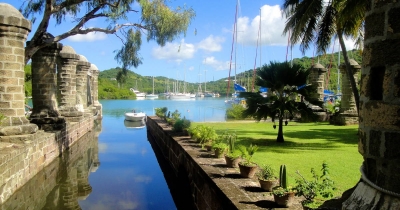
About the site
Antigua Naval Dockyard and Related Archaeological Sites consists of a group of buildings and structures in Gregorian-style, set within a walled enclosure. The dockyard and the related structures were built by the British as a strategic naval base in the battle for supremacy of the seas of the Caribbean between the European countries.
The dockyard offered shelter from the infamous hurricanes that the islands would often witness, making it ideal for repairing ships.
The British would not have been able to construct the dockyard and the related sites if not for the labour of generations of African slaves since the end of the 18th Century.
While many of the buildings and fortifications in the area are in ruins, the dockyard continues to function.
Nelson’s Dockyard
The Antigua Naval Dockyard is popularly known as Nelson’s Dockyard. The largest of Antigua’s National Parks, Nelson’s Dockyard is still used as a working dockyard for yachts and ships.
Nelson’s Dockyard was built by the British in the early 18th Century with the main aim of maintaining the British Royal Navy warships which were protecting Britain’s sugar-producing islands in the region.
The dockyard is named after Horatio Nelson, the British Hero of Trafalgar, who served as the captain of the H.M.S. Boreas. He was sent to Antigua by the British to enforce British laws, especially the Navigation Act, which barred foreign ships from trading with British colonies. This made him hugely unpopular with the local merchants, who were trading with the U.S. Nelson, who hated the place, spent most of his time there in the cramped quarters of his ship.
The British closed down the dockyard in 1889, after the sugar industry waned. In the years following its abandonment, Nelson’s Dockyard was battered by earthquakes and hurricanes. In the 1950s, the dockyard underwent major restoration and was officially named after Nelson.
The strategic advantage
While the construction of the dockyard began as early as the 1720, its strategic importance increased when Britain lost the American War of Independence.
After its loss, the British had two enemies to protect its sugar-producing islands from – the U.S. and France. The British had to protect these islands as the sugar from the Caribbean was finding the Industrial Revolution and the development of Britain.
The deep narrow bays of the south coast of Antigua were the perfect spot for the British to build its dockyard. Surrounded by highlands that create a natural harbour, the location offered shelter from the hurricanes that often struck the Caribbean islands. Known as the English harbour, this gave Britain the advantage of retaining its fleet and repairing its ships while other countries had to send their fleet back during the hurricane season.
Antigua’s location also offered the British control over major sailing routes to and from the rich island countries.
Related sites
Apart from the dockyard itself, there are several fortifications and other buildings inside the dockyard that are part of the UNESCO heritage site.
Among these are the Clarence house, the Officer’s Quarters and the Senior Officer’s House built in the English Gregorian style but adapted to suit the climatic conditions of the Caribbean.
Shirley Heights Lookout, a military complex is a famous tourist spot offering panoramic views of the harbour. The complex is named after Sir Thomas Shirley, Governor of the Leeward Islands, who strengthened the island’s defences in 1781 by building this lookout.
Another site that was discovered only in 2010, after a hurricane uncovered well-preserved human remains, prompting for an extensive excavation project, is Galleon Beach. This former burial site for British sailors who fell victim to the yellow fever outbreaks, also falls within the boundaries of the Dockyard.
The Dockyard today
Offering many sites and activities for visitors to explore, Nelson’s Dockyard is today a popular tourist place.
The Dockyard Museum exhibits the Dockyard’s history and presents the current archaeological research on the island. There are several shops, hotels and marina businesses housed in the buildings in the dockyard, while outside the dockyard, one can hike to some of the historic forts such as Fort Charlotte and Fort George that dot the landscape.
Picture Credit : Google

